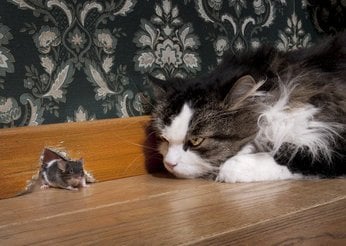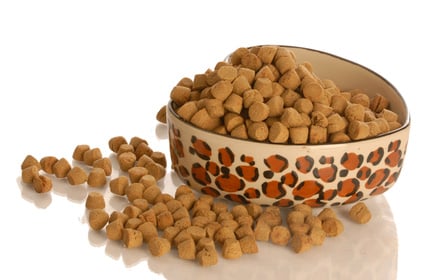 Creating a food hunt for your indoor cat is one of the most effective ways to enrich his life. It is because hunting so relates to the natural behavior of your pet, and hunting is what most cats spend the most time for in the wild.
Creating a food hunt for your indoor cat is one of the most effective ways to enrich his life. It is because hunting so relates to the natural behavior of your pet, and hunting is what most cats spend the most time for in the wild.
The downside of this activity is that it requires involvement from the owner. It’d be much easier if we could sit our cat in front of the TV and that’s it. It’s how we do with our kids, but not gonna work for cats that well. So, a food hunt is a must.
It’s not hard to get a cat’s attention on food, is it?
Start by getting a few kibbles of your cat’s dry food. It might work with other types of food as well, but it’s messier, so I suggest sticking to dry kibbles. They make a very intriguing sound when falling on the floor. And this is how you start.
Show a kibble to your cat if he’s not purring next to you already after hearing the sound of food tray opening. When his attention is on you, drop the kibble down.
Wait till your cat finishes eating it. It’s important to let him eat it without the need to rush. Then throw another one.
If your cat shows no interest (you do have a cat, right?), make sure he’s not full already. If he just ate lunch, food might not be the motivation right now. Try some other time or start by just playing with him. Introduce food now and then during play.
When your cat got the idea of hunting a food kibble, it’s time to make it more interesting to both of you by trying different types of throw. Throw a kibble next to your feet, so you can pet your cat when he comes, throw it rolling on the floor away from your cat, so he can imagine it’s a prey running away. Throwing so your cat does not see it, but hears where it lands makes a lot of curiosity. A spot where it’s hard to get the kibble out may be one more option. And if your cat is already advanced, try encouraging him catching a kibble in the air, or rolling by him in a very high speed. These are just a few examples of how to create kibble throwing more interesting. Try to vary a throw to throw so your cat does not get bored.
If your cat gets tired and becomes lazy (may happen quite soon at first), it’s time to take a break.
Subtract food used in hunting from daily intake
 Remember to subtract food you use in hunting from your cat’s daily portion. Even though your cat works for it, it’s still food and getting too much may lead to obesity and several health problems that even fact your cat is more active now, won’t help.
Remember to subtract food you use in hunting from your cat’s daily portion. Even though your cat works for it, it’s still food and getting too much may lead to obesity and several health problems that even fact your cat is more active now, won’t help.
At some point, you may reach the state when you feed all of your cat’s daily intake by hunting. However, do not rush reaching this point, as routine is very important to cats and not getting a bowl of food at the usual time, will make your cat confused and stressed, no matter if he’s hungry or not.
There or several other way’s you can make your cat “work” for his food. Be sure, he will not resent it. Getting an interactive toy where your cat has to figure out, how to get a piece of food that’s inside, or hiding small amounts of food in several places throughout your house are most common examples. However, they are not as fun (they’re still a lot of fun, but nut as much) as throwing kibbles, ad they do not simulate natural pattern of food hunting, also may require some training at first. On the other hand, owner involvement is reduced. And that’s good for you.
